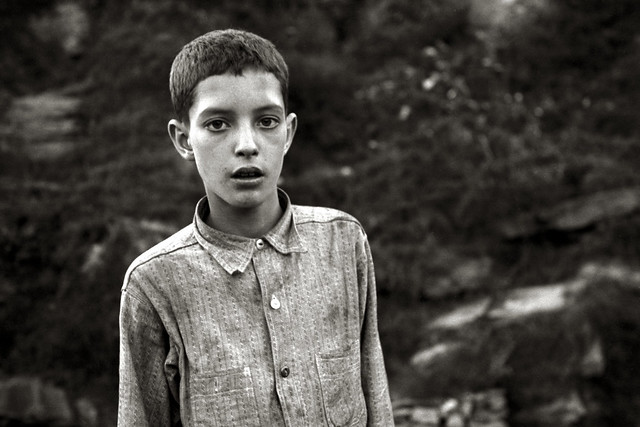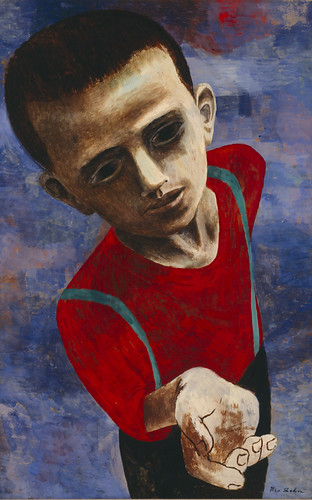Dust, Drought, Depression, and War No. 17
The Bitter Years No.21

Coal miner’s child, Omar, West Virginia,
October 19352
The boy in this image was a subject in at least two of the numerous photos taken in the Omar, West Virginia area in 1935 and 1938 by photographers employed by the federal government in Franklin Roosevelt’s New Deal. There is no background information on this boy available online, who he was then, or what became of him later.
The visits to Omar were part of a larger effort that would take thousands of photographs across America between 1935 and 1943. Fifteen photographers took over two thousand photographs in West Virginia alone.3
Photographs from the Omar area visits are included in history books, photographic art books, other print media, and, today, on many websites. Many have been featured in art museums and other photographic exhibits preserving images of a slice of everyday life in Omar and the vicinity during the Great Depression.4
Photographer Ben Shahn, a Lithuanian-born American artist is best known for artworks of social realism, left-wing political views, and a series of art lectures published as The Shape of Content.5
While Shahn was primarily an artist, in the early 1930s he became interested in photography, capturing street-level views of life in New York neighborhoods.6, 7
In late September 1935, Shahn left New York to work for the Resettlement Administration. He worked as an artist in the agency’s Special Skills Division and was an unofficial, part-time member of Roy Stryker’s photographic section.8
His first photographic assignment gave him the opportunity to travel for a month through the southern United States where photographing scenes of rural poverty exposed him to lives far different from what he had known living in New York.9
 Shahn later did a painting (1946) called Hunger in which some think the subject resembles the child in the photo.10 The image was used by the Congress of Industrial Organizations (CIO) in a voter registration drive.11 It was reproduced in Look magazine in 1947, along with six others “to illustrate a hostile editorial provocatively titled ‘Your Money Bought These Paintings’.”12 The original painting is in the Jule Collins Smith Museum of Fine Art’s permanent collection at Auburn University.13
Shahn later did a painting (1946) called Hunger in which some think the subject resembles the child in the photo.10 The image was used by the Congress of Industrial Organizations (CIO) in a voter registration drive.11 It was reproduced in Look magazine in 1947, along with six others “to illustrate a hostile editorial provocatively titled ‘Your Money Bought These Paintings’.”12 The original painting is in the Jule Collins Smith Museum of Fine Art’s permanent collection at Auburn University.13
- The 1962 exhibition, “The Bitter Years 1935-1941,” was Edward Steichen’s last as Director of the Department of Photography at New York’s Museum of Modern Art (MoMA). The images in the exhibition were personally selected by Steichen from 270,000 photos taken for the Farm Security Administration by a team of photographers employed between 1935 and 1941 to document (primarily) rural America during the Great Depression.
- Poos Françoise. The Bitter Years: Edward Steichen and the Farm Security Administration Photographs. New York: D.A.P./Distributed Art Publishers, Inc., 2012. page 58
- “The Omar Project: Not a Simple Story.” West Virginia Department of Arts, Culture and History. Accessed September 12, 2021. http://www.wvculture.org…omar….
- “Introductory Notes: The Omar Project: Not a Simple Story.” West Virginia Department of Arts, Culture and History. Accessed September 12, 2021. http://www.wvculture.org…omar.
- Shahn, Ben. The Shape of Content. Cambridge: Harvard University Press, 1957. (checkout available at Internet Archive)
- Shahn had pursued art and, with his wife, made “the traditional artist pilgrimage,” via North Africa and Europe, and had studied great European artists Henri Matisse, Raoul Dufy, Georges Rouault, Pablo Picasso, and Paul Klee. Dissatisfied with his work inspired by his travel, he redirected his efforts toward a realistic style he used to contribute to social dialog.
-
- “Ben Shahn.” Wikipedia, edit as of July 18, 2021. Accessed September 12, 2021. https://en.wikipedia.org…Shahn.
-
- In the early 1930s, though known as a painter, muralist, and graphic artist, Shahn was making formidable photographs. Between 1932 and 1935, Shahn’s street photography showed life in New York city through “the prosaic activities and expressive gestures of ordinary people.” He also “documented demonstrations for expanded work-relief programs and protest marches against social injustice…” His New York photography addressed such topical issues as unemployment, poverty, immigration, and social reform and their connection to race and class.
- “Ben Shahn’s New York: The Photography of Modern Times.” Grey Art Gallery, September 13, 2016. Accessed September 12, 2021. https://greyartgallery.nyu.edu/….
- Gertz, Stephen J. “Book Illustrator Ben Shahn Does Poster.” Booktryst, May 16, 2013. http://www.booktryst.com/….
- “Ben Shahn’s New York…”
- “Omar Project: Photos (Page 3).” West Virginia Department of Arts, Culture and History. Accessed September 12, 2021. http://www.wvculture.org…photos3.html.
- Gertz.
“…’it represents, perhaps, the best of Shahn’s poster work. One cannot soon erase the memory of the hollow-eyed young face begging for peace. Nowhere is Shahn’s genius for drawing more evident than in the thrust of the pleading hand…Using the image of this child in the context of an election campaign seems to say that in a democracy the first step toward healing the ravages of war is to exercise one’s right to vote’ (Kenneth W. Prescott, The Complete Graphic Works of Ben Shahn, p. 132)” - Bailey, Julia Tatiana. “’Realism Reconsidered’: Ben Shahn in London, 1956 – Essay.” Tate, 2019. https://www.tate.org.uk….
- Shahn, Ben. “Hunger.” Jule Collins Smith Museum of Fine Art, 1946. Accessed September 12, 2021. http://jcsm.auburn.edu….


Comments on this entry are closed.
Please read my email to you. Thanks.
read it… and replied.